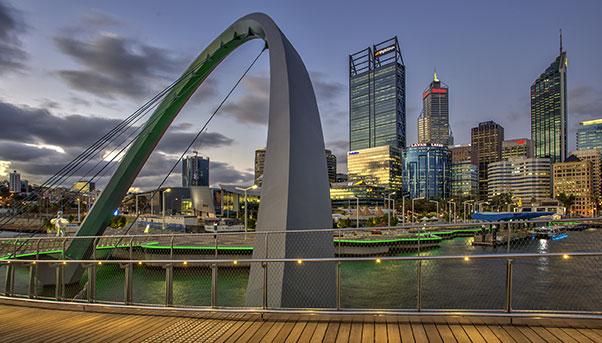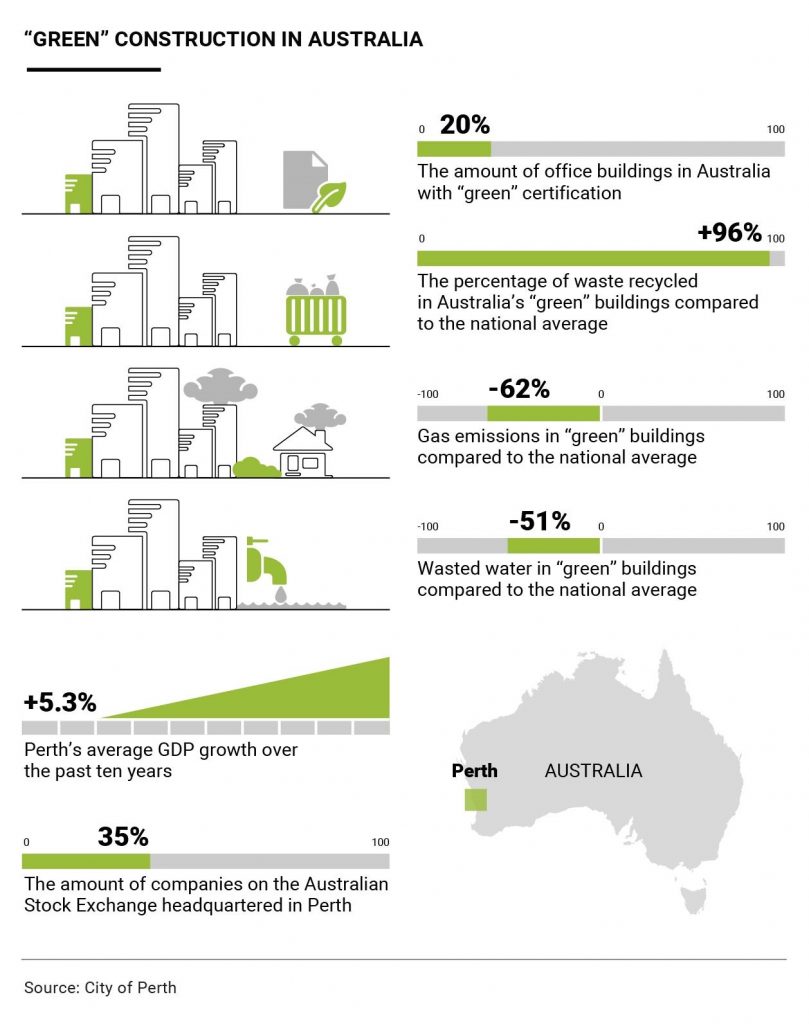
The tour starts at 235 St George’s Terrace, with a backpack on our shoulders and our gaze pointed skywards to admire the glass office tower designed by the architects fitzpatrick+partners. The building was awarded with one of Western Australia’s highest certification levels for its environmental sustainability, and is the first stop on the Sustainable Perth Walking Tour through the city centre organized by the Green Building Council (a regulator in charge of the Green Star environment certifications). The tour is a two-kilometre walk highlighting the Australian city’s leadership in the field of “green” buildings.
One of them is the Green Skills Training Centre, which has been named the “greenest” public building in the state of Western Australia, thanks to its super-modern solar power plant that produces 100% of the building’s energy needs as well as running the heating and air conditioning.
All across Australia, new buildings constructed since 2003 can be assigned a “Green Star” rating ranging from 1 to 6. The rating system is managed nationally by the Green Building Council of Australia.
In Perth, buildings are increasingly being designed as “green” right from the start. It’s not a coincidence that the city now celebrates a “Green Building Day.” The last one took place on June 1 in honor of sustainable buildings and was attended by construction firms, architects, technicians and city government representatives.
The idea of developing a city to be totally in harmony with the environment and user-friendly is now so deeply entrenched that in 2017 the city government launched a two-year program that offers economic support to business owners and landlords who commit to respecting “green” criteria. Last year the city also launched the “Strategic Community Plan,” a long term plan focusing on not just sustainability but also on the city’s overall development in order to make Perth a place with a high quality of life, and committed to energy usage, water conservation and dealing with climate change.
Perth: Important green projects for city development
Today Perth is the focus of a frenetic infrastructure program, founded on principles of environmental protection and innovative construction techniques. Topping the long list is the $2.6 billion Elizabeth Quay waterfront development. The international airport is getting an $1 billion facelift; $428 million is being spent for the “New Museum for WA” dedicated to the state’s history; and $1.2 billion is earmarked for the Forrestfield-Airport Link, a light railway (built by a consortium comprised of Salini Impregilo Group and Australia’s NRW) that will link the airport to various areas in the city giving a boost to business and tourism. Taken together, these new infrastructure works will help modernize the entire city, improving its transportation and liveability.

The Economic Context of Perth city
This big infrastructure push, accompanied hand in hand with a growing interest in protecting the environment, is deeply linked to the city’s economic vitality. The state of Western Australia, of which Perth is the capital, boasts a GDP of $198 billion which is 42% higher than the national average. Perth is a logistical hub, with four direct flights each week to the airport in Guangzhou, China, which serves one of the most developed areas in the entire world. This city of 2 million people (78% of the population of Western Australia) has posted an average GDP growth of 5.3% in the past 10 years. This performance has helped support investments and transformed the city into an economic hub to the point where 35% of the cities listed on the Australian Stock Exchange have their headquarters in Perth. All of these factors helped it reach seventh place in the Economist’s World’s Most Liveable City survey.
The Australian Experience in Green Buildings
“Green” buildings have been popping up across Australia in recent years, not just in Perth. The country boasts a multitude of innovative buildings and 20% of offices currently have a “green” certificate. The benefits of this choice are evident: buildings constructed according to “green” certification produce 62% fewer gas emissions than average, use 51% less water and recycle 96% of waste.
For example, The Commons building in Melbourne was named the country’s most sustainable building in 2014. Made up of 24 apartments, it has no parking spaces for cars — just for 65 bicycles. Not only that: it was built from cement-covered “cells” that are so totally isolated from the exterior that no air conditioning is needed.
In Sydney the French architect Jean Nouvel (the designer of the Louvre Abu Dhabi) created the Central Park building, which received a Green Star rating of 5 in 2013. The building’s excellence comes from the fact that 70% of water consumed for domestic use is recycled, reusing such sources as rain water and irrigation water from the terrace gardens. The building also has its own natural gas plant.
This is the road Australia has taken and will continue to follow for the years to come. Its choice shows not only that it cares about protecting the environment, but also demonstrates a will to find innovative and high tech solutions to solve construction problems in a modern way.

